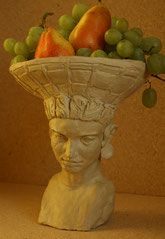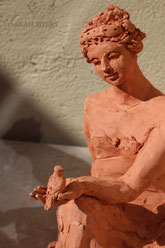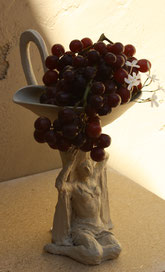Figures in ceramic clay are probably one of the oldest forms of sculpture in the world - they are certainly one of the most direct. The malleable material captures every touch of the artist; thought goes smoothly and easily from mind to hand to the clay itself, which retains even the most fugitive mark.
In the early days of mankind the clay figure, after being baked in the fire, stood by itself as a creation, a decorative object, small idol, a memorial. In later art history, the rough clay study was often the preliminary rendering for a larger sculpture in stone, wood or metal. But it was the original clay 'modello' where the artist first outlined his image and ideal for the finished piece.
The life and spontaneity that is preserved when working directly in terracotta or other ceramic clay is precious to me, and the ease with which thought can be converted to form is invaluable. The exuberant energy of earth touched by the human hand still holds the worth it possessed when mankind was young. My fingers, with or without the help of a wooden tool, work rapidly over the responsive lump of clay to help a face, a body, emerge from the material - until the image in my mind and the image in my hands mirror each other, speak to each other.
I generally sculpt as quickly as I dare, knowing that a shorter time and more efficient use of effort is likely to minimize both the possible damage during drying and shrinking, and also the risk from losing the energy of my original concept. Once the artwork seems to waken with a sense of reality, of presence, I finish as rapidly as I began - leaving not only the imprint of my idea but also of my effort in the clay, where the heat of a kiln-fire will transform this momentary evidence into the lasting statement of a sculpture with its own expression and its own vitality.



















































